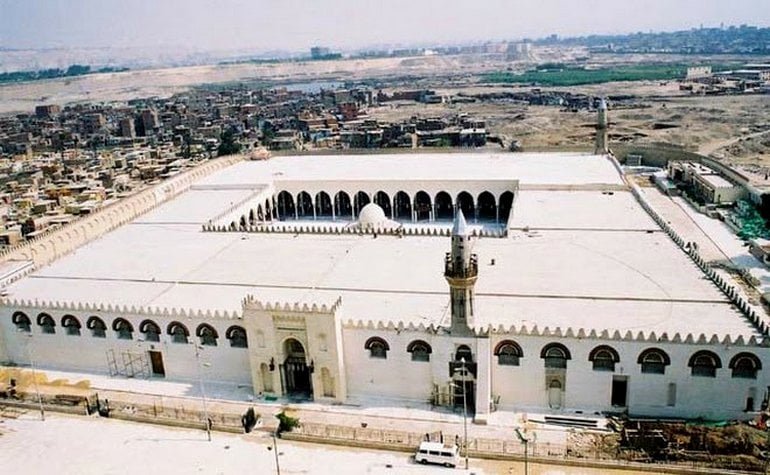The Mosque of Amr Ibn El-Aas is Egypt’s only mosque that has coexisted with all Egyptian governments since the Arabic conquest in 639 AD until today. The mosque has evolved significantly over 1400 years. It began as a small little mosque and grew over time to become known as the “Crown of Mosques.” In the past, the mosque was used for more than just congregational prayers. It functioned as a court and a treasury to collect funds for the destitute.
Who was Amr Ibn El-Aas?
Amr Ibn El-Aas was one of the great dignitaries of Quraish (famous Arabian Tribe). El-Aas Ibn Wael El-Sahmiy, his father, was a wealthy merchant. Amr fought against the Muslims in the Battle of Badr. He also fought against the Muslims in the Battle of Uhud and the Battle of the Confederations. Amr became a Muslim at the hands of Negus, King of Abyssinia, in the eighth year of the Islamic calendar.
In 639 AD, Amr requested Caliph Omar to conquer Egypt. Omar gave him a hesitant nod. Amr went into El-Arish, then El-Farma. When he arrived in Belbis, he sought Omar’s assistance. Omar dispatched a legion led by Ez-Zubair Ibn El-Awam to him. They entered Fayoum, then they were stationed in Ain Shams. They seized Babylon’s fortress until they were able to enter it in 640 AD.
They marched from Cairo to Alexandria and seized it. The seizure ended with a peace treaty. Amr became Egypt’s first Muslim ruler. He founded the city of El-Fustat as Egypt’s capital, where he built his mosque. So Islam arrived in Egypt in 640 AD, and the majority of the Egyptians are Muslims.
Amr was deposed by Caliph Othman in 24 AH. During the reign of Caliph Ma’wia Ibn Abi Sufian, he regained control of Egypt. Amr died at the age of 88 and was buried near El-Muqqatam Mountain in Egypt.
History of the mosque:
The Nile River’s course was to the east of today’s course at the time of the Arab Conquest. Amr’s Mosque was Egypt’s first holy site for Muslims to pray congregationally and Friday prayers.
Amr designed his mosque to be 50 cubits long and 30 cubits wide. Its ceiling was made of dates leaves and mud and was supported by palm trunks. The mosque did not have a minaret or a minbar (pulpit) as it does today. The mosque had two doors on each of its three sides: east, west, and north. Amr constructed his home on the east side of his mosque.

The mosque was unchanged until the reign of Muslima Ibn Mukhalad. In 672 AD, he added to its northern side. In 798 AD, Abdel Aziz Ibn Marwan expanded the mosque on its western side.
Egypt’s ruler, Prince Qurah Ibn Shuraik, destroyed the mosque and built a larger one on the same site. He also built a minaret, which became known as the Egyptian type of minarets. He also added a wooden Minbar (pulpit) and a hollow Mihrab. So, by this time, the mosque had four doors on its eastern side, four on its western side, and three on its northern side.
Abdullah Ibn Taher expanded the mosque twice in 827 AD. After Fustast’s fire in 888 AD, Khumarawiah restored the mosque. Caliph Al-Zaziz Billah added a fountain and a new minbar to the mosque in 988 AD. The mosque was destroyed during Fustat’s second fire in 1168, but it was rebuilt by Saladin.
Mamluk Sultan El-Zaher Bibars restored Amr’s mosque. Following the earthquake of 1302 AD, Sultan An-Nassir Mohamed rebuilt the mosque.
Murad Bik completely demolished the mosque and replaced it with a new one. In 1798, he introduced the last Friday Prayer of Ramadan in the mosque. Four marble foundation stelae bear witness to his deed. The first stela is located above the mosque’s western door, the second is located above the middle door, the third is located above the big Mihrab, and the fourth is located above the smaller Mihrab.
In 1798-1801, Napoleon’s army wrecked the Amr Mosque. It was renovated by Mohamed Ali Pasha, and his descendants carried on the work. Despite this, the colonnades on the east and west were destroyed in 1883.
The grave of Abdullah Ibn Amr Ibn El-Aas is now located in the mosque’s eastern corner. The tomb was originally located outside the mosque, but when the mosque was expanded, it was moved within.
The mosque’s southern wall was cut with three mihrabs: the larger Mihrab, which stands beside the Minbar, the middle Mihrab, and the 5-prayer Mihrab. Murad Bik is thought to have created the larger mihrab.
Description of Mosque:
The mosque is comprised of a great open court, surrounded by four colonnades with modest timber ceilings. The biggest colonnade of the four is the Qiblah Colonnade. The Qiblah Colonnade has two mihrabs and a wooden minbar. Two foundation stelae also date from the Mamluk period. The grave of Abdullah Ibn Amr can be seen on the colonnade’s northern eastern side.

A domed fountain is in the center of the mosque’s great open court. Eight marble columns support the dome of the fountain. The Qiblah colonnade’s marble columns were salvaged from older structures. The mosque’s main entrance is placed on its western side. The minaret of the mosque is shaped like a cylinder.

